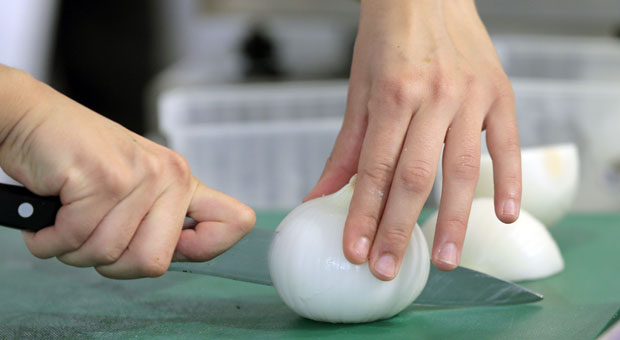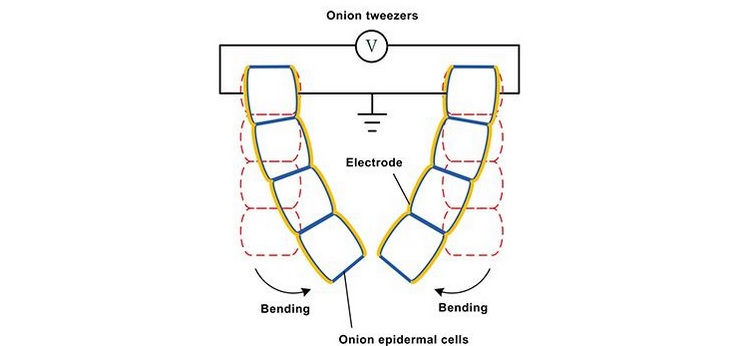Synthetic muscle built from gold-plated onion skin
New discovery could be a 'valuable tool' for healthcare as well as the 'emerging world of soft robotics'

Scientists have used onion cells to develop a new and inexpensive class of artificial muscle that can bend and contract at the same time.
In a world first, physicists in Taiwan discovered that the onion's epidermis – the delicate layer of skin between the layers of an onion – could help them create a cheaper and more versatile muscle for use with humans and robots.
"The initial goal was to develop an engineered micro-structure in artificial muscles for increasing the actuation deformation [the amount the muscle can bend or stretch when triggered]," said lead researcher Wen-Pin Shih.
The Week
Escape your echo chamber. Get the facts behind the news, plus analysis from multiple perspectives.

Sign up for The Week's Free Newsletters
From our morning news briefing to a weekly Good News Newsletter, get the best of The Week delivered directly to your inbox.
From our morning news briefing to a weekly Good News Newsletter, get the best of The Week delivered directly to your inbox.
"One day, we found that the onion's cell structure and its dimensions were similar to what we had been making," he said.
The onion cells were coated with gold electrodes to make them move like muscles. Scientists were able to make them expand or contract to bend in different directions depending on the voltage used.
To demonstrate its application, the scientists developed muscle-like "tweezers" made up of the coated cells, which they used to pick up a cotton ball.

But the tweezers were only strong enough to pick up 2mg at a time and required a high voltage, which developers say is the concept's main drawback. "We will have to understand the configuration and mechanical properties of the cell walls better to overcome this challenge," explained Wen-Pin Shih.
A free daily email with the biggest news stories of the day – and the best features from TheWeek.com
Artificial muscles have a wide range of real-word applications, from helping people with debilitating injuries to powering robots.
"If the new muscle becomes viable for production, it could be a valuable tool for the emerging world of soft robotics," says The Verge. Robots can currently only perform simple motor functions such as contracting, expanding and rotating, but experts hope that advancements in technology might one day combine all of those functions into a "single, all-purpose" muscle.
-
 What have Trump’s Mar-a-Lago summits achieved?
What have Trump’s Mar-a-Lago summits achieved?Today’s big question Zelenskyy and Netanyahu meet the president in his Palm Beach ‘Winter White House’
-
 The most anticipated movies of 2026
The most anticipated movies of 2026The Week Recommends If the trailers are anything to go by, film buffs are in for a treat
-
 The biggest viral moments of 2025
The biggest viral moments of 2025In the Spotlight From the Coldplay concert kiss cam to a celebrity space mission, these are some of the craziest, and most unexpected, things to happen this year
-
 First crocodile virgin birth recorded
First crocodile virgin birth recordedfeature And other stories from the stranger side of life
-
 Growing number of people ‘actually aliens’
Growing number of people ‘actually aliens’feature And other stories from the stranger side of life
-
 Home Office worker accused of spiking mistress’s drink with abortion drug
Home Office worker accused of spiking mistress’s drink with abortion drugSpeed Read Darren Burke had failed to convince his girlfriend to terminate pregnancy
-
 In hock to Moscow: exploring Germany’s woeful energy policy
In hock to Moscow: exploring Germany’s woeful energy policySpeed Read Don’t expect Berlin to wean itself off Russian gas any time soon
-
 Were Covid restrictions dropped too soon?
Were Covid restrictions dropped too soon?Speed Read ‘Living with Covid’ is already proving problematic – just look at the travel chaos this week
-
 Inclusive Britain: a new strategy for tackling racism in the UK
Inclusive Britain: a new strategy for tackling racism in the UKSpeed Read Government has revealed action plan setting out 74 steps that ministers will take
-
 Sandy Hook families vs. Remington: a small victory over the gunmakers
Sandy Hook families vs. Remington: a small victory over the gunmakersSpeed Read Last week the families settled a lawsuit for $73m against the manufacturer
-
 Farmers vs. walkers: the battle over ‘Britain’s green and pleasant land’
Farmers vs. walkers: the battle over ‘Britain’s green and pleasant land’Speed Read Updated Countryside Code tells farmers: ‘be nice, say hello, share the space’